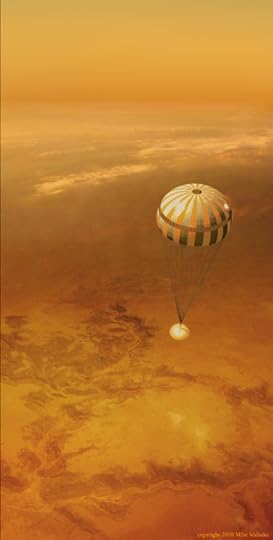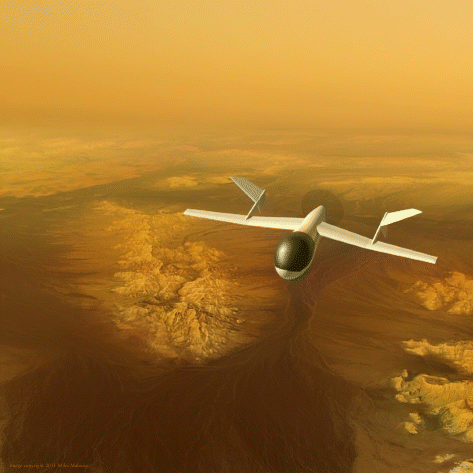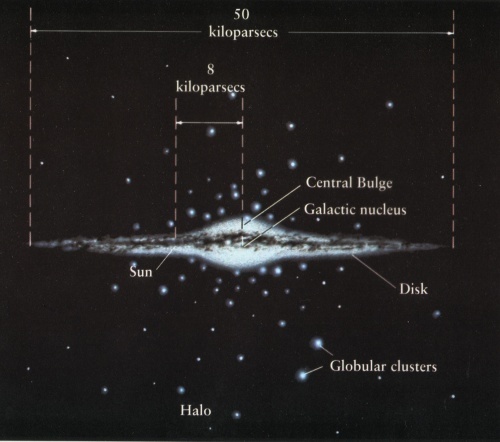Paul Gilster's Blog, page 247
April 9, 2012
Reasons for a Human Future in Space
I closed last week with two posts about the AVIATR mission, an unmanned airplane that could be sent to Titan to roam its skies for a year of aerial research. It's a measure of Titan's desirability as a destination that it has elicited so many mission proposals, and I want to get into the Titan Mare Explorer (TiME) as well, but let's pause a moment to consider the nature of what we're doing. Out of necessity, all our missions to the outer system have been unmanned, but as we learn more about long-duration life-support and better propulsion systems, that may change. The question raised this past weekend in an essay in The Atlantic is whether it should.
Ian Crawford, a professor of planetary sciences at Birkbeck College (London) is the focus of the piece, which examines Crawford's recent paper in Astronomy and Geophysics. It's been easy to justify robotic exploration when we had no other choice, but Crawford believes not only that there is a place for humans in space, but that their presence is indispensable. All this at a time when even a return to the Moon seems beyond our budgets, and advanced robotics are thought by many in the space community to be the inevitable framework of all future exploration.
But not everyone agrees, even those close to our current robotic missions. Jared Keller, who wrote The Atlantic essay, dishes up a quote from Steve Squyres, who knows a bit about robotic exploration by virtue of his role as Principal Investigator for the Spirit and Opportunity rovers on Mars. Squyres points out that what a rover could do even on a perfect day on Mars would be the work of less than a minute for a trained astronaut. Crawford accepts the truth of this and goes on to question what robotic programming can accomplish:
"We may be able to make robots smarter, but they'll never get to the point where they can make on the spot decisions in the field, where they can recognize things for being important even if you don't expect them or anticipate them," argues Crawford. "You can't necessarily program a robot to recognize things out of the blue."
Landing astronauts is something we've only done on the Moon, but the value of the experience is clear — we've had human decision-making at work on the surface, exploring six different sites (some of them with the lunar rover) and returning 382 kilograms of lunar material. The fact that we haven't yet obtained samples from Mars doesn't mean it's impossible to do robotically, but a program of manned exploration clearly points to far more comprehensive surface study. Crawford points out that the diversity of returned samples is even more important on Mars, which is more geologically interesting than the Moon and offers a more complicated history.
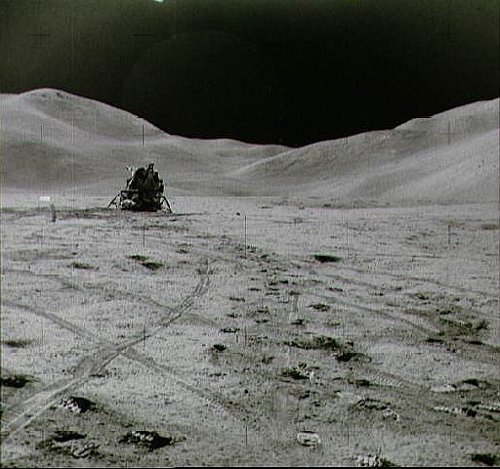
Image: Apollo 15 carried out 18.5 hours of lunar extra-vehicular activity, the first of the "J missions," where a greater emphasis was placed on scientific studies. The rover tracks and footprints around the area give an idea of the astronauts' intense activity at the site. Credit: NASA.
Sending astronauts by necessity means returning a payload to Earth along with intelligently collected samples. From Crawford's paper:
Robotic explorers, on the other hand, generally do not return (this is one reason why they are cheaper!) so nothing can come back with them. Even if robotic sample return missions are implemented, neither the quantity nor the diversity of these samples will be as high as would be achievable in the context of a human mission — again compare the 382 kg of samples (collected from over 2000 discrete locations) returned by Apollo, with the 0.32 kg (collected from three locations) brought back by the Luna sample return missions.
It's hard to top a yield like that with any forseeable robotic effort. Adds Crawford:
The Apollo sample haul might also be compared with the ≤ 0.5 kg generally considered in the context of future robotic Mars sample return missions… Note that this comparison is not intended in any way to downplay the scientific importance of robotic Mars sample return, which will in any case be essential before human missions can responsibly be sent to Mars, but merely to point out the step change in sample availability (both in quantity and diversity) that may be expected when and if human missions are sent to the planet.
Large sample returns have generated, at least in the case of the Apollo missions, huge amounts of refereed scientific papers, especially when compared to the publications growing out of robotic landings. Crawford argues that it is the quantity and diversity of sample returns that have fueled the publications, and points out that all of this has occurred because of a mere 12.5 days total contact time on the lunar surface (and the actual EVA time was only 3.4 days at that). Compare this to the 436 active days on the surface for the Lunokhods and 5162 days for the Mars Exploration Rovers. Moreover, the Apollo publication rate is still rising. Quoting the paper again:
The lesson seems clear: if at some future date a series of Apollo-like human missions return to the Moon and/or are sent on to Mars, and if these are funded (as they will be) for a complex range of socio-political reasons, scientists will get more for our money piggy-backing science on them than we will get by relying on dedicated autonomous robotic vehicles which will, in any case, become increasingly unaffordable.
Will the Global Exploration Strategy laid out by the world's space agencies in 2007 point us to a future in which international cooperation takes us back to the Moon and on to Mars? If so, science should be a major beneficiary as we learn things about the origin of the Solar System and its evolution that we would not learn remotely as well by using robotic spacecraft. So goes Crawford's argument, and it's a bracing tonic for those of us who grew up assuming that space exploration meant sending humans to targets throughout our Solar System and beyond. That robotic probes should precede them seems inevitable, but we have not yet reached the level of artificial intelligence that will let robots supercede humans in space.
The paper is Crawford, "Dispelling the myth of robotic efficiency: why human space exploration will tell us more about the Solar System than will robotic exploration alone," Astronomy and Geophysics Vol. 53 (2012), pp. 2.22-2.26 (abstract).






April 6, 2012
A Closer Look at the Titan Airplane
Yesterday's discussion of the AVIATR mission to Titan inevitably brought up another prominent Titan mission concept: Titan Mare Explorer (TiME). I'll have more to say about this one next week, as today I want to continue talking about AVIATR, but you can once again see how Titan enthralls us with its 'Earth-like' aspects. Need a thick atmosphere around a moon? Titan is your only play, and if, as with TiME, you want to put an instrument package into an off-planet surface lake, you'll be hard pressed to do it anywhere else, at least in this Solar System.
These two mission concepts fire the imagination — they're the kind of thing kids like me used to dream about when we plunked down our money at the newsstand for copies of Galaxy or Fantasy & Science Fiction. It's unlikely, though, that both missions will fly. If TiME, which is a Discovery-class mission finalist and thus cost-capped at $425 million, is chosen, then the odds on AVIATR probably drop. AVIATR, a New Frontiers-class mission, ups the cost to $715 million, and because it didn't make it into the National Research Council's 'Decadal Survey,' the mission will be pushed back into the next decade at the earliest even if TiME loses out to a competing proposal.
Soaring in Titan's Skies
Nonetheless, this is one intriguing idea. One of the benefits of using an actual aircraft — as opposed to the balloon concept envisioned in the Titan Saturn System Mission (TSSM) concept — is that AVIATR would not be carried at random by the local winds, but would have the ability to fly directly to a location and to remain at that site for as long as needed to study it. It would be capable of descending for close-in, high-resolution views (3.5 kilometers) and then returning to a cruising altitude somewhere in the neighborhood of 14 kilometers. There would be, in other words, no latitude restrictions for AVIATR, which unlike a balloon would be able to visit high-latitude lakes and polar regions as easily as the equatorial zone.
In terms of maximizing science, then, AVIATR is holding plenty of cards, and I haven't even mentioned the fact that because the airplane would be flying at a significant fraction of Titan's rotational velocity, flying west could keep our instruments on Titan's daylight side for longer periods, maximizing the scientific return as well as the communications link with Earth. The airplane could also be conceived as fitting into a broader pattern of Titan exploration:
In addition to its own science, AVIATR could be a pathfinder for future landed missions at Titan – one of our objectives is to "Identify potential landing sites of scientific interest and constrain their safety". Using our full instrument complement would allow us to discover places on Titan at which future missions may elect to land. These places may be of interest for geological, geophysical, chemical, meteorological, or astrobiological reasons. The best spatial resolution of the AVIATR cameras will be of the same order as that of HiRISE at Mars (25 cm/pixel), and this data will be able to constrain the engineering safety of surface environments for landers.
This could be a critical factor in future missions:
Such landing-site candidate analysis may include characterization of rock hazards, slope determinations, the persistence of liquid, and rover trafficability. Our global wind field measurements can reduce the size of the landing ellipse for those future missions as they descend through the atmosphere to their destinations.
Image: An artist's conception of the parachuted descent portion of the AVIATR EDD sequence. Credit: Mike Malaska.
And while a large imaging instrument like HiRISE on the Mars Reconnaissance Orbiter can map the Martian surface in detail, we lack the same kind of imaging capability for Titan because of the opacity of the atmosphere and because orbiters need to keep to altitudes higher than 1000 kilometers here, so the kind of close-in look AVIATR can provide is otherwise unavailable.
A 'Gravity Battery'
Taking advantage of AVIATR's ability to climb and descend as needed, the team has worked out an ingenious method of power management that uses excess power — available when the vehicle is not transmitting data back to Earth — to climb to high altitude, storing these energies as gravitational potential energy in a process the team refers to as a 'gravity battery.' During periods of data transmission, the power to the propeller is drastically reduced and the extra power made available is then used to boost transmitted power for the uplink to Earth.
The plan the team discusses in their paper is to have one 8-hour downlink session to the Earth each day:
At the start of a downlink we cut power to the propeller, using that power instead to improve the total radiated power from the telecommunications dish. The airplane then glides for the entire duration of the roughly 8-h downlink (Fig. 34). Once we arrive at our lowest safe altitude of 3.5 km we return to straight and level flight and reduce the transmitter power if the downlink session is still ongoing. Otherwise at the cessation of the downlink we would again pour the extra energy into the propeller, beginning a new climb. We call this mode of operation "climb/glide".
The team figures AVIATR can manage a one-year mission, but the paper also notes that there are no expendables here that limit the aircraft's total lifetime beyond the gradual decay of the plutonium-238 that powers the Advanced Stirling Radioisotope Generators (ASRGs). We've gotten used to missions that extend well past their intended lifetime, and the AVIATR vehicle's electrically powered pusher propeller could keep it airborne until the onset of some kind of mechanical failure. If that happens, or if it runs out of funding, AVIATR would descent to an area of soft dunes on Titan, possibly producing still more science for at least a brief period.
While we wait to see whether AVIATR makes it as a New Frontiers mission into the next planetary science decadal survey, a variety of matters still need attention, especially the question of the power output of the ASRGs in the atmosphere of Titan. Also needed: A tune-up of the instrumentation to Titan-specific conditions. All told, though, the AVIATR team sees no showstoppers here and strongly urges Titan airplanes as a part of future missions to the moon. See yesterday's entry for the full citation of the paper on this work.






April 5, 2012
AVIATR: Roaming Titan's Skies
Each of our highest priority targets in the outer Solar System offers something unique, from Europa's internal ocean to the geysers of Enceladus. But Titan exerts the kind of fascination that comes from the familiar. The imagery of lakes and river channels reminds us inescapably of our home world, even if the temperature on the Saturnian moon averages a brisk 94 K, which works out to -291 degrees on the Fahrenheit scale. But because of its thick atmosphere we have options for exploring Titan that are unavailable on the other icy moons, and we're working with a landscape that is a compelling frozen doppelgänger of Earth, a landscape we'd like to explore up close.
As we saw yesterday, part of the outer system puzzle is getting supplies of plutonium-238 up to speed, and there is at least some movement on that front. If we want to get aggressive about exploring Titan, one excellent way to deploy that plutonium is aboard AVIATR (Aerial Vehicle for In-situ and Airborne Titan Reconnaissance), a 120 kg airplane that could study the moon's atmosphere from within and give us views of its geography on demand. Under study by a team led by Jason Barnes (University of Idaho), the airplane could do some things a balloon could not, including not being at the mercy of equatorial winds and being more flexible in studying some of the interesting terrain around high-latitude lakes and in the turbulent weather near the poles.
I've been thinking about AVIATR and other Titan options this week because last weekend I had the chance to speak with Mike Malaska, an organic chemist who has been collaborating with members of the Cassini team in research that involves characterizing the Sikun Labyrinth canyon-land region and hydrocarbon channels located near Titan's South Pole. I discovered that Mike is also a volunteer artist for the AVIATR mission proposal. Like I said, Titan fires the imagination, and the idea of a human aircraft in operations there sounds too fascinating not to attempt. Mike's image of the unmanned AVIATR vehicle flying over the surface of Titan is below.
Image: A rendering of the AVIATR airplane flying over Titan. Credit: Mike Malaska.
But back to that thick atmosphere, which helps us on Titan in so many ways. In an environment where gravity is seven times less than on Earth, we're dealing with an atmospheric pressure one and a half times greater than Earth's. It was Robert Zubrin who suggested, back in the 1990s, that humans with wings strapped to their arms would be able to fly in this thick and soupy environment. We've already seen evidence of this atmosphere's effect on the Huygens probe, which took fully two and a half hours to descend to the surface in early 2005.
A paper on the AVIATR concept notes Titan's advantages:
With an Earth-like surface shaped by rainfall and atmospheric interaction, a rich and complex chemistry, and the astrobiological potential of complex organic molecules interacting with liquid water, Titan is one of the three most interesting targets in the solar system for planetary exploration. Like Mars, but unlike Europa, Titan can be explored inexpensively. Although cruise times to Titan are long (∼7 years), arrival at Titan is easy. Titan's dense atmosphere with a large scale height is perfect for decelerating landers and aerial elements cheaply and with low heating and acceleration loads. Orbiters at Titan can be mass-efficient, too, if they utilize aerocapture…
The plutonium-238 issue becomes still more interesting because the new type of radioisotope thermoelectric generators NASA is examining seem made to order for an airplane in Titan's atmosphere, while they're unlikely to function in alternative balloon proposals. Called Advanced Stirling Radioisotope Generators (ASRG), the new RTG's are considerably more efficient than their predecessors, requiring less plutonium-238 and producing less waste heat. Barnes and team argue in their paper that a hot-air balloon would not work on Titan with an ASRG because of its lower heat production — balloon designs would need to function with the waste heat from an MMRTG [Multi-Mission Radioisotope Thermoelectric Generator]. In fact, Barnes' calculations show that the 500 W of heat from an ASRG would support less than 10 kg in a balloon, which is actually less than the mass of the ASRG itself.
Contrast this with AVIATR, which can use the longevity of twin ASRGs for extended operations on Titan. Setting aside the power requirements for computers, actuators and instruments, Barnes and company find they have in the neighborhood of 80 W to power up the propeller for straight and level flight operations. From the paper:
The propeller's thrust on an airplane with singly folded wings can keep aloft an airplane with a mass up to ∼120 kg. Other nuclear power sources, such as the MMRTG, cannot satisfy the physical requirements for heavier-than-air flight at Titan subject to appropriate engineering and risk constraints. Thus the use of an ASRG makes the AVIATR mission concept possible…
In fact, once deployed in Titan's atmosphere, AVIATR should be in a benign environment:
Heavier-than-air flight on Titan is easier than anywhere else in the solar system. With over 4 times more air and 7 times less gravity than Earth, flight on Titan is 28 times easier than it is here (in the sense that a vehicle with the same contours flying at the same velocity on both planets could lift 28 times more mass). It is over 1,000 times easier on Titan than on Mars.
Long-duration flight is the name of the game, and AVIATR is seen as capable of carrying out a 1-year mission. The stability of the design would return the aircraft to straight and level flight in case the autopilot failed, in which case stabilizing vanes would deploy automatically to keep the aircraft in a stable position while pointing its antenna at the Earth to receive safe-mode instructions. The paper notes that the materials for the airframe are conventional and based on designs for unmanned aerial vehicles (UAVs) that operate here on Earth. AVIATR would also be more robust than a balloon in handling atmospheric turbulence and wind shear.
How would AVIATR be deployed, and how would it conduct flight operations? More on this tomorrow, when I want to dig a little deeper into the science and the unusual telecommunications strategy afforded by an aircraft on Titan. The paper is Barnes et al., "AVIATR—Aerial Vehicle for In-situ and Airborne Titan Reconnaissance: A Titan airplane mission concept," Experimental Astronomy, Volume 33, Issue 1 (2011), pp.55-127 (full text).






April 4, 2012
Plutonium-238 and the Outer System
Powering up a spacecraft is a lot easier to manage in the Sun-rich environment inside the orbit of Mars than it is out past the orbit of Jupiter. Solar panels provide plenty of power for a satellite in near-Earth orbit, for example, but moving into the outer system invokes the need for RTGs — radioisotope thermoelectric generators — powered by radioactive decay. If you read through the specs on the FOCAL mission design presented here last Friday, you saw that this attempt to reach the Sun's gravitational lens would demand 20 RTGs, and thus requires resumed production of plutonium-238.
What's happened is that US production of 238Pu was halted as far back as 1988, leaving us with stockpiles that should be sufficient for missions in the pipeline through the end of this decade. That's the view of Leonard Dudzinski, NASA's Radioisotope Thermoelectric Generator program executive, who was speaking at the opening session of the 43rd Lunar and Planetary Science and the Nuclear and Emerging Technologies for Space 2012 conferences. The two conferences were held in conjunction with each other in Texas from March 19 to 23.
There have been negotiations between the US and Russia to buy plutonium from Moscow, but according to Dudzinski. quoted in a release from Aviation Week Aerospace Daily & Defense Report, the talks have stalled and, in any case, Russia's own supplies of plutonium are rapidly dwindling.
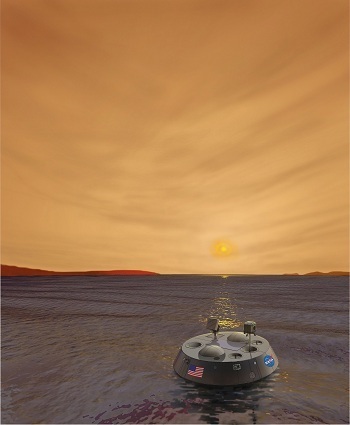
Thus it's good to hear that NASA and the Department of Energy are poised to fund and restart the production of plutonium-238 within six to seven years — NASA won congressional approval to spend $10 million during 2012 on the restart and is seeking similar amounts in 2013-14. Meanwhile, the development of the Advanced Stirling Radioisotope Generator (ASRG) continues, the latter possibly to be used on Discovery-class missions like the Titan Mare Explorer (TiME) and Comet Hopper, both of which are being reviewed by NASA for a 2016 launch.
Image: Artist's impression of the Titan Mare Explorer (TiME) capsule. TiME would perform the first direct inspection of an ocean environment beyond Earth by landing in, and floating on, a methane-ethane sea on Saturn's largest moon. Credit: Johns Hopkins University Applied Physics Laboratory/Lockheed Martin.
From the report:
DOE is close to completing a restart assessment that attempts to make the best use of current production facilities to generate 1.5-2 kg (3.3-4.4 lb.) of plutonium-238 annually… In all, NASA counts 28 of the radioactively fueled missions over a half century, requiring a 3-kg average annual production. The Voyager 1 and 2 missions, launched in 1977, remain active as they exit the Solar System.
Of more modern vintage are the Mars Science Laboratory (MSL) and Curiosity rover, along with the New Horizons mission, which is scheduled for a flyby of Pluto/Charon in 2015. The Advanced Stirling Radioisotope Generator (ASRG) has never flown, but it would be useful indeed, increasing the heat-to-power-generation efficiency of plutonium to 30% from the 5-7% allowed by the solid-state RTGs in use on MSL and New Horizons. As the various agencies move to restart plutonium-238 production, a parallel step will be to learn whether ASRG is flight-worthy.
It's worth considering the context in which all this occurs:
The provocative backdrop includes the proposed sharp drop in proposed spending on planetary science in NASA's 2013 budget; an ambitious decadal road map from the National Research Council (NRC) that includes missions to assess the habitability of Jupiter's moon Europa and Saturn's moons Enceladus and Titan; and a three-year-old NRC report that warns U.S. space leadership is imperiled if it does not resume plutonium-238 production.
Missions to the outer system demand RTG power sources, without which the exploration of high-value targets like Titan and Enceladus cannot proceed. We should learn this year whether the TiME mission, which would attempt to land a probe in one of the lakes of Titan, or the Comet Hopper mission to explore a comet from its surface are selected. In any case, a wide range of potential missions remain in the queue, including the fascinating AVIATR, an ambitious concept to fly a heavily instrumented airplane through the thick atmosphere of Titan. I'll be talking more about AVIATR tomorrow as we continue to ponder power generation in deep space.






April 3, 2012
Planets Around an Ancient Star
The idea of 'deep time' exerts an abiding fascination. H.G. Wells took us forward to a remote futurity when his time traveler looked out on a beach dominated by a red and swollen Sun. But of course deep time goes in the other direction as well. I can remember wanting to become a paleontologist when I discovered books about the world of the dinosaurs, my mind reeling from the idea that the world these creatures lived in was as remote as any distant star. Paleontology was a grade-school ambition I never followed up on, but the Triassic and Jurassic eras still have a hold on my imagination.
In a SETI context, deep time presents challenges galore. Charles Lineweaver's work offers up the prospect that the average Earth-like planet in our galactic neighborhood may well be far older than our own — Lineweaver calculates something like an average of 1.8 billion years older. Would a civilization around such a star, if one could survive without destroying itself for so long, have anything it wanted to say to us? Would it have evolved to a level where it had merged so completely with its environment that we might not be able to recognize its artifacts even if we saw them?
All these musings were triggered by the news from the Max-Planck-Institut für Astronomie (Heidelberg) that European astronomers have discovered a planetary system that is truly ancient. The star in question is HIP 11952, about 375 light years from Earth in the constellation Cetus. Not surprisingly, given its estimated age of 12.8 billion years, it is extremely metal poor, but two giant planets are now known to orbit it. Says Johny Setiawan (MPIA), who led this work:
"This is an archaeological find in our own backyard. These planets probably formed when our Galaxy itself was still a baby."
The planets around HIP 11952, which have orbital periods of 7 and 290 days, thus present us with a challenge. Elements heavier than hydrogen and helium are what astronomers consider 'metals,' and we've seen through our ongoing analysis of exoplanets that stars with higher metal content are more likely to have planets. We also have a mechanism for metal formation in which heavier elements are produced inside stars and blown into space through the explosion of supernovae. That a star as old as HIP 11952 should have planets would seem to be a rare thing indeed, but we do have another metal-poor system around HIP 13044, discovered back in 2010.
There is no doubt about the low metallicity of HIP 11952, which has an iron abundance approximately 1 percent that of the Sun. This is a population II star, one of the class that includes the oldest and most metal-poor stars that have yet been observed. Our own solar neighborhood is comparatively metal-rich and contains stars younger than 10 billion years. It's an interesting speculation (followed up in this expanded news release from MPIA) that HIP 11952 may be a remnant from another galaxy that was absorbed by the Milky Way billions of years ago.
Image: Population II stars tend to have orbits that take them outside the plane of the galactic disk, and are often associated with globular clusters and the galactic halo. Because of their age, most of them consist of almost pure hydrogen and helium, unenriched by earlier generations of stars. Credit: Hsiang-Kuang Chang/Tsing Hua University (Taiwan).
Are there, then, more planets around metal-poor stars than we have previously thought? We need to find more planetary systems in this age bracket to learn more, but Anna Pasquali (Heidelberg University), a co-author of the paper on this work, says "The discovery of the planets of HIP 11952 shows that planets have been forming throughout the life of our Universe," a thought that reminds us to be careful about drawing hasty conclusions about planet formation. Don't be surprised, either, if the idea doesn't once again bring Dr. Fermi knocking at the door.






April 2, 2012
Re-Thinking The Antimatter Rocket
Once when reading Boswell's monumental life of the 18th Century writer and conversationalist Samuel Johnson, I commented to a friend how surprised I had been to discover that Johnson didn't spend much time reading in his later years. "He didn't need a lot of time," replied my friend, a classics professor. "He tore the heart out of books." That phrase stuck with me over the years and re-surfaced when I started working with Adam Crowl. More than anyone I know, Adam can get to the heart of a scientific paper and explain its pros and cons while someone like myself is still working through the introduction. And because of his fine work with Project Icarus, I thought Adam would be just the person to explain the latest thinking about a classic concept that Friedwardt Winterberg would like to take to the next level.
by Adam Crowl
In Jules Verne's From the Earth to the Moon, the bold Frenchman Michel Ardan, in his first speech to the Baltimore Gun Club, when discussing travelling to the Moon via a cannon-shell, makes the following statement…
Well, the projectile is the vehicle of the future, and the planets themselves are nothing else! Now some of you, gentlemen, may imagine that the velocity we propose to impart to it is extravagant. It is nothing of the kind. All the stars exceed it in rapidity, and the earth herself is at this moment carrying us round the sun at three times as rapid a rate… Is it not evident, then, I ask you, that there will some day appear velocities far greater than these, of which light or electricity will probably be the mechanical agent?
Rockets replaced cannon-shells as the preferred means of interplanetary travel in the early 20th Century, thanks to the work of Tsiolkovksy, Goddard, Oberth and Noordung. They took up Verne's insight and developed Ardan's hand-waving further. Applying electricity to rocket motion resulted in the Ion Rocket, and applying light, the Photon Rocket. However the first rocket scientist to propose an engineering solution to how light might be directly harnessed to rocket propulsion, rather than just pushing solar-sails, was Eugen Sänger [1].
Antimatter and the Photon Rocket
Sänger's discussion of photon rockets showed clearly how difficult it would be – every newton of thrust would require 300 megawatts of photon energy released. Any vehicle generating photons by conventional means would be confined to painfully low accelerations, thus Sänger proposed using matter-antimatter reactions, specifically the mutual annihilation of electrons and positrons, with the resulting gamma-rays (each 0.511 MeV) being reflected by an electron-gas. Unfortunately the electron-gas mirror would need a ridiculously high density, seen only in white-dwarf stars.
The next stage for the matter-antimatter photon rocket saw the work of Robert Forward [2], and more recently Robert Frisbee [3], who applied more modern knowledge of particle physics to the task. Instead of instant and total annihilation of proton-antiproton mixtures, resulting in an explosion of pure high-energy gamma-rays in all directions, the reactions instead produce for a brief time charged fragments of protons, dubbed pions, which can be directed via a magnetic field. According to theoretical analyses by Giovanni Vulpetti [4], in the 1980s, and more recently by Shawn Westmoreland [5], the theoretical top performance of a pion rocket is a specific impulse equivalent to 0.58c. However the pion rocket isn't strictly a pure photon rocket and suffers from the inefficiency of magnetic nozzles. Simulations by John Callas [6] at JPL, in the late 1980s suggested an effective exhaust velocity of ~1/3 the speed of light could be achieved.
The other difficulty of matter-antimatter propulsion, as graphically illustrated by Frisbee's work, is the extreme difficulty of storing antimatter. The old concept of storing it as plasma is presently seen as too power intensive and too low in density. Newer understanding of the stability of frozen hydrogen and its paramagnetic properties has led to the concept of magnetically levitating snowballs of anti-hydrogen at the phenomenally low 0.01 K. This should mean a near-zero vapour pressure and minimal loses to annihilation of the frozen antimatter. What it also means is immensely long and thin spacecraft designs. Frisbee's conceptual designs are literally the size of planets, thousands of kilometres long, but merely metres wide. This minimises the gamma-radiation exposure of heat-sensitive components and maximises the exposure of radiators to the cosmic heat-sink. To achieve 0.5c, using known materials, results in vehicles massing millions of tonnes [3].
Harvesting the Fire
Friedwardt Winterberg's recent preprint [7] suggests a different concept, with the promise of near total annihilation and near perfect collimation of a pure gamma-ray exhaust. Poul Anderson described such a vehicle's operation in fiction in his Harvest the Fire (1995), describing an advanced matter-antimatter rocket – the exhaust was so efficiently directed that it was invisible for thousands of kilometres before finally appearing as a trail of scattered energy. So what is Winterberg proposing?
We've encountered Winterberg's work before [8] in Centauri Dreams in his designs for deuterium fusion rockets, and his new work is an outgrowth of his work on the magnetic collapse of ions into incredibly dense states. Using the technique he describes, high compression of fusion plasma can be achieved, but in the case of a matter-antimatter ambiplasma (a plasma that is an even mix of the two) the result is even more spectacular.
Essentially what Winterberg describes is generating a very high electron-positron current in the ambiplasma, while leaving the protons-antiprotons with a low energy. This high current generates a magnetic field that constricts rapidly, a so-called pinch discharge, but because it is a matter-antimatter mix it can collapse to a much denser state. Near nuclear densities can be achieved, assuming near-term technical advancements to currents of 170 kA and electron-positron energies of 1 GeV. This causes intensely rapid annihilation that crowds the annihilating particles into one particular reaction pathway, directly into gamma-rays, pushing them to form a gamma-ray laser. By constricting the annihilating particles into this state a very coherent and directional beam of gamma-rays is produced, the back-reaction of which pushes against the annihilation chamber's magnetic fields, providing thrust.
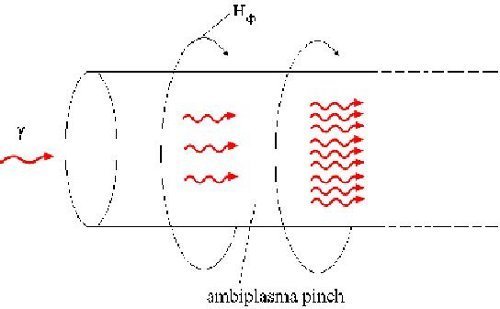
Figure 1. [from Ref.7] Gamma-ray Laser
The figure above depicts the processes involved – the magnetic field of the ambiplasma (from the electron-positron current) squeezes a linear atom of protons-antiprotons which begin annihilating, stimulating more annihilation, all in one direction from the annihilation being triggered at one end of the discharge. Thanks to the very confined channel created by the magnetic pinch, the laser beam produced has very limited spread. Intense magnetic-field recoil is created by the firing of the gamma-beam, with a pulsed field-strength of 34 tesla. The recoil force can thus be transferred back to the vehicle by the right choice of conductor surrounding the reaction chamber.
Winterberg ends his paper with an anecdote about Edward Teller, one of the many fathers of the H-bomb, who was of the opinion that photon rockets would eventually be possible – in "500 years" which equates to "impossible" in the minds of the short-sighted. Certainly making antimatter efficiently will be a Herculean task, as the energy requirements are immense. Storing it is equally "impossible". However, as Winterberg notes, there might be a quicker pathway to confinement.
Over the last decade researchers at the University of Gothenburg, led by Leif Holmlid, have been studying exotic states of deuterium. In the past two years they have reported [9] an ultra-dense state, which has also been independently computed [10] to form inside low-mass brown-dwarf stars. This exotic quantum liquid is one million times denser than liquid deuterium and apparently a superconducting superfluid at room-temperature. Only minute amounts have been made and studied so far, but such a material could be able to sustain intense magnetic fields, up to 100,000 tesla. If it can be manufactured in large amounts, and is stable in intense magnetic fields, then the problem of magnetic confinement of anti-hydrogen at friendlier temperatures becomes more tractable.
To quote Winterberg [7], paraphrasing Teller…
Therefore, if nature is kind to us, the goal for a relativistic photon rocket might be closer than the 500 years prophesized by Teller.
References
[1] E. Sänger, 4th International Astronautical Congress, Zürich, Switzerland 3-8 August 1953.
[2] R.L. Forward, "Antiproton Annihilation Propulsion", AFRPL TR-85-034, (1985)
[3] G. Vulpetti, "Maximum terminal velocity of relativistic rocket," Acta Astronautica, Vol. 12, No. 2, 1985, pp. 81-90.
[4] S. Westmoreland, "A note on relativistic rocketry," Acta Astronautica, Volume 67, Issues 9-10, November-December 2010, pp. 1248 – 1251.
[5] J.L. Callas,"The Application of Monte Carlo Modeling to Matter-Antimatter Annihilation Propulsion Concepts," JPL Internal Document D-6830, October 1, 1989.
[6] R. H. Frisbee, 39th AIAA/ASME/SAE/ASEE Joint Propulsion Conference, Huntsville, AL, July 2003, AIAA-2003-4676
[7] F. Winterberg, "Matter-Antimatter GeV Gamma Ray Laser Rocket Propulsion", 2011 (preprint).
[8] F. Winterberg, "Advanced Deuterium Fusion Rocket Propulsion For Manned Deep Space Missions", JBIS Vol.62 No 11/12 (2009).
[9] P.U. Andersson and L. Holmlid, "Superfluid ultra-dense deuterium D(-1) at room temperature". Phys. Lett. A 375 (2011) 1344–1347. doi:10.1016/j.physleta.2011.01.035.
[10] L.Berezhiani, G.Gabadadze and D.Pirtskhalava, "Field Theory for a Deuteron Quantum Liquid", JHEP 1004, 122 (2010). Preprint available.






Correction re WISE
Last week I reported on information from a source on the WISE mission that no new red dwarfs had yet been discovered out to a distance of 10 light years. This past weekend I received an email from my source apologizing for mis-typing. He had meant to say no brown dwarfs — not red dwarfs — out to a distance of 10 light years. And as I mentioned with the earlier post, the data analysis continues and there may be surprises yet to come.
A nearby brown dwarf is something I've been writing about here for some time, pondering its implications and wondering whether one might actually turn up that was closer than the Alpha Centauri stars. So the news is that no brown dwarfs matching the description have yet turned up, but the hunt continues.






March 30, 2012
Interstellar (Precursor) Mission & Vehicle Design
by Marc Millis
Tau Zero's first graduate student project has been completed. Berkeley Davis, a 2nd Lt. at the United States Air Force Institute of Technology, Dayton Ohio, completed his Masters thesis on a deep space probe to perform Claudio Maccone's gravitational lens mission (FOCAL). For those unfamiliar with FOCAL, it is a mission to utilize the gravitational lens effect that begins at approximately 550 AU from the Sun, one that in the view of Maccone will offer huge magnifications for the study of targets like the Cosmic Microwave Background. For more, see the Centauri Dreams archives.
IMPETUS
Maccone, Deep Space Flight and Communications: Exploiting The Sun as a Gravitational Lens (Springer, 2009).
MISSION/VEHICLE STUDY
Davis, Berkeley. R. (2012) Gravitational Lens: The Space Probe Design (Thesis), AFIT/GA/ENY/12-M06, Air Force Institute of Technology.
To provide a realistic baseline on what is possible, the student was asked to constrain his design to commercially off-the-shelf technology. The mission involves taking a 12 m diameter radio telescope beyond 550 Astronomical Units (AU), continuing outward thereafter, to examine the gravitational lensing of our own Sun. A secondary mission, which occurs before that point, is to measure the magnetic fields, particles, and dust while traveling through our Solar System and the transition through the edge of our Solar System (the termination shock, the heliosheath, heliopause) and into true interstellar space.
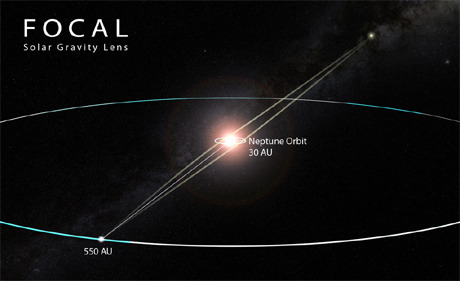
Image: Beyond 550 AU, we can start to take advantage of the Sun's gravitational lens, which may allow astrophysical observations of a quality beyond anything we can do today. Credit: Adrian Mann.
In short, it is found that this mission could be performed with EXISTING technology for roughly $3B-$5B (FY 2011 dollars), and that it would take roughly 34 years to reach the edge of our Solar System, and roughly 110 years to reach its primary mission point of 550 AU, and continuing thereafter for almost 80 years of data taking until the spacecraft reaches about 1000 AU, where it will have likely exceeded its 2-century life-time projection.
Using those goals and constraints, the student designed a two-stage vehicle that is delivered into orbit by a "Delta IV-H/Star48/Star37″ launcher. The 1st stage, which has a 22 kW solar array, uses four "NEXT" ion thrusters to propel the vehicle from Earth orbit to Jupiter while thrusting almost constantly in a spiral trajectory for 17 years.
At Jupiter that boost stage is jettisoned, and the main stage completes a Jupiter gravity assist. The main stage also includes four "NEXT" ion thrusters powered by 20 Radioisotope Thermal Generator (RTGs) which have roughly 4.4 kW at this point in the mission. The spacecraft thrusts continuously for roughly another 17 years until the propellant runs out at roughly 90 AU. At this point its velocity is 6.7 AU/yr which is almost twice the speed of Voyager (3.6 AU/yr).
For the next 20 or so years it coasts through the border between our Solar System and true interstellar space, taking data for the secondary mission. Then after about 55 more years, it reaches 550 AU, the closest point where gravitational lensing would ideally begin. By this point its velocity has slowed to 6.2 AU/yr. It takes another 12 years to reach 625 AU, which is the closest predicted for observable signals at the focal point. The spacecraft will continue coasting outward for the next 60 years and will be able to continue taking data (observations of our Sun's gravitational lensing) until the spacecraft passes 1000 AU roughly 180 years after launch. Provisional estimates of the number of cycles of the attitude control system, processor, etc, suggest that this vehicle might function for 2-centuries.
The thesis also made the following recommendations:
- Since spacecraft power is the most limiting technological factor at this time, that should be the focus of next-step research for interstellar missions.
- To complete such missions with RTGs, the production of Plutonium-228 would have to fully resume.
- Mission durations are longer than practical for on-Earth life tests, so novel testing techniques will need to be created to ensure the spacecraft will still be functioning by the time it reaches its interstellar mission location.
- Note: Mission uses about 10% of total annual Xenon production – Xenon which will not return to Earth.
This study was merely a first-cut at examining these possibilities, and these findings should not be considered the last work on this specific topic.
Mission StageDistance from Sun (AU)Mission YearSpacecraft Power (kW)Spacecraft Mass (kg)
Launch1008608
Earth Orbit (270 km)22.0 + 4.9
Solar + RTG8608
Reaches Jupiter5.2174.4 + 4.3
Solar + RTG5586
Jettison Boost Stage4.3
RTG4236
Jupiter Gravity Assist
Runs out of Propellant90343.72323
Exits Solar System23054
Reaches closest FOCAL550109
Reaches viable FOCAL625121
End of Life10001811.22223
EXTRA INFORMATION
Boost stage
4 Ion Thrusters = 225 kg (615-7225 kW)
Xe tank = 309 kg
Xe load = 2996 kg
Solar Power 900 kg, 22 kW
Thrusts from LEO to Jupiter
Jettisoned at Jupiter
Main Stage
4 Ion Thrusters = 225 kg (615-7225 kW)
Xe tank = 217 kg
Xe load = 1888 kg
RTG Power: 20 General Purpose Heat Source Radioisotope Thermal Generators
Each 58 kg, 246W initially, with half-life of 90 yrs
12 Attitude control thrusters, 0.8 kg ea
Attitude Control Propellant Tanks = 12 kg
Attitude Control Propellant = 151 kg
Science Payload, 51kg, 40W
• 12 m radio telescope (doubles as communication High Gain Antenna)
• Magnetometers
• Particle detectors
• Dust detection
Thrusts from Jupiter to 200 AU (runs out of propellant)
Coasts from 200 AU outward
100 kBit/sec @1000AU






March 29, 2012
ESO: Habitable Red Dwarf Planets Abundant
Red dwarfs are all over the news thanks to an announcement by the European Southern Observatory. Results from a new HARPS study show that tens of billions of planets not much larger than Earth are to be expected in the habitable zones around this class of star. The finding reinforces the growing interest in M-class stars and becomes especially interesting when you realize that faint red stars like this make up as much as 80 percent of the stars in the Milky Way. That leaves plenty of room for astrobiology, depending on factors we need to discuss below.
Do we suddenly have a close destination for a potential interstellar probe? Well, Barnard's Star has always been in the running for an early mission because of its relative proximity to us at 5.94 light years. But we still have no word on planets there (despite a much publicized but soon discredited set of observations from a 1969 paper). Proxima Centauri is available at 4.2 light years, but we have yet to learn whether it has planets. And as far as anything closer, a source on the WISE team passes along the information that no new red dwarfs have been discovered, as of yet, within 10 light years, though of course the WISE results are still under heavy analysis.

Image: This artist's impression shows a sunset seen from the super-Earth Gliese 667 Cc. The brightest star in the sky is the red dwarf Gliese 667 C, which is part of a triple star system. The other two more distant stars, Gliese 667 A and B appear in the sky also to the right. Astronomers have estimated that there are tens of billions of such rocky worlds orbiting faint red dwarf stars in the Milky Way alone. Credit: ESO/L. Calçada.
But back to the ESO announcement, which focuses on results obtained with the HARPS spectrograph at La Silla. Let me quote Xavier Bonfils (Institut de Planétologie et d'Astrophysique de Grenoble) directly on this:
"Our new observations with HARPS mean that about 40% of all red dwarf stars have a super-Earth orbiting in the habitable zone where liquid water can exist on the surface of the planet. Because red dwarfs are so common — there are about 160 billion of them in the Milky Way — this leads us to the astonishing result that there are tens of billions of these planets in our galaxy alone."
What the work comes down to is a survey of 102 M-class stars studied over a period of six years, in which nine super-Earths with masses up to ten times that of Earth were found. 460 hours of observing time went into the mix, with 1965 radial velocity measurements made between 2003 and 2009. Interestingly, more massive planets like Jupiter and Saturn turn out to be rare around such stars, with fewer than 12 percent of them expected in M-dwarf systems. From all this, the team thinks that there should be about 100 super-Earth planets in the habitable zones of stars within about 30 light years of the Sun.
We can point to interesting worlds like Gliese 667Cc — discovered in the HARPS survey — as a promising preview of what is out there. This is a planet within a triple star system that is about four times the mass of the Earth and orbits close to the center of the habitable zone. But even assuming an abundance of super-Earths in conditions allowing liquid water on the surface, we still have the old M-class problems to contend with. A habitable world around such a small star needs to orbit close to it, leading to the potential for tidal lock and creating climate conditions that may not favor life. We also know that red dwarfs are frequently flare stars, creating unique evolutionary pressures on any life that does manage to emerge.
Xavier Delfosse (IPAG, Grenoble), another member of the team working the HARPS data, is lead author on one of two papers examining the results that have recently become available. The outlook on tidal locking is troubling but perhaps not a show-stopper for astrobiology, at least not if our own Solar System is any indication. Although a habitable M-dwarf planet is likely to be captured into a spin-orbit resonance, it will not necessarily be forced into synchronous rotation. From the paper (I've omitted internal references for brevity — the paper citations are below):
The final equilibrium rotation of a tidally influenced planet depends on both its orbital eccentricity and the density of its atmosphere… Mercury, for instance, has been captured into the 3:2, rather than 1:1, spin-orbit resonance…, and Venus has altogether escaped capture into a resonance because thermal atmospheric tides counteract its interior tides… Whatever the final spin-orbit ratio, the tidal forces will influence the night and day succession, and therefore the climate. As discussed above however, energy redistribution by an atmosphere at least as dense as that of the Earth is efficient… and will prevent glaciation and atmospheric collapse on the night side.
And what about stellar flare activity? M-dwarfs are more active than G-class stars like the Sun, with the result that a planet in the habitable zone of a young M-dwarf takes a huge hit from X-ray and ultraviolet radiation, a period of irradiation 10 times longer than the approximately 100 million years that the Solar System dealt with similar activity on our star. How planetary atmospheres evolve under such conditions, and whether they can actually be stripped away by coronal mass ejections, are issues we haven't as yet resolved. Digging into the Delfosse paper I find several points worth noting on the matter:
We don't have a good read on just how frequent coronal mass ejections from M-dwarfs are, and how intense they tend to be. Right now these questions need more investigation, though the authors believe the frequency may be less than some earlier studies have indicated.
A strong magnetosphere can help to shield a planet that would otherwise be imperiled.
The atmospheric chemistry and composition may be key, and there is one study that shows that around active M-dwarfs with an atmosphere consisting mostly of CO2, the atmosphere remains stable despite nearby flare and CME activity.
The paper summarizes the issue this way:
These differences imply that a planet in the habitable zone of an M dwarf is unlikely to be a twin of the Earth. Habitability however is not restricted to Earth twins, and Barnes et al. (2010) conclude that "no known phenomenon completely precludes the habitability of terrestrial planets orbiting cool stars." A massive telluric planet, like Gl667Cc (M2.sin i = 4.25 M⊕), most likely has a massive planetary core, and as a consequence a stronger dynamo and a more active volcanism. Both factors help protect against atmospheric escape, and super-Earths may perhaps be better candidates for habitability around M dwarfs than true Earth-mass planets.
So there we are: Tens of billions of rocky planets in the habitable zones of red dwarfs, and perhaps 100 relatively near to the Sun, according to the estimates of these researchers. What we need to do now is increase the red dwarf planet inventory with future instruments made to order — state of the art near-infrared spectrographs that, in the authors' estimate, should be able to identify between 50 and 100 planets in the habitable zones of M-dwarfs. That should be enough, even with a 2-3% transit probability, to find at least one transiting habitable world.
The Delfosse et al. paper is "The HARPS search for southern extra-solar planets XXXV. Super-Earths around the M-dwarf neighbors Gl433 and Gl667C," submitted to Astronomy & Astrophysics (abstract). The Bonfils paper is Bonfils et al., "The HARPS search for southern extra-solar planets XXXI. The M-dwarf sample," submitted to Astronomy & Astrophysics (full text). The ESO news release is also available.






March 28, 2012
An Interstellar Reminiscence
by A. A. Jackson
Although it was probably science fiction that got Al Jackson into interstellar flight, he remembers discovering the work of Eugen Sänger back around 1960 and becoming energized to seek out the few scientific papers on relativistic rocket designs that were then available. With a firm background in engineering, he turned to physics in 1975, receiving a PhD from the University of Texas at Austin, a natural move for a man who had worked for NASA during the heyday of Apollo as astronaut trainer on the Lunar Module Simulator. Going through Al's papers is a fascinating exercise in its own right, but I was reminded because of our recent articles on Robert Bussard's ramjet ideas that Al had worked with Daniel Whitmire.
Bussard spoke about fusing protons in his ramscoop engine, but subsequent analysis showed that the power needed to compress protons to fusion densities far outweighed the power that would be produced. It was Daniel Whitmire who developed the 'catalytic ramjet' idea we looked at yesterday, in which the starship draws its power through the much more energetic CNO cycle, a catalytic cycle that is the dominant energy source in stars more than 1.3 times the mass of the Sun. Thus the 'catalytic ramjet' was born, and Al would go on to collaborate with Whitmire on a laser ramjet in a paper the two published in 1977. I asked Al if he had any reminiscences of Whitmire and this period and he was kind enough to send the following.
I was looking at Bussard's original paper the other day and I noticed he does mention without elaborating too much the idea of using a magnetic scoop and the attendant problems with synchrotron and bremsstrahlung radiation. He just did not do a quantitative calculation of these things. Seems to me it was Sagan who gave a long discussion, in print, of using a mag scoop, though that was not quantitative either, so I think Bussard and Sagan originated that idea.
Rather than making any technical comments, let me tell you a story. When I was at the University of Texas from 1970 to 1975 I used to go to the physics library a lot. I am a real library haunter… I noticed there was another grad student there as much as me, which got me curious. He noticed me too. Well I introduced myself to the guy, who turned out to be Dan Whitmire. We became boon friends, have been now for, lord, nearly 40 years. (Have not really seen much of Dan in the last 10 years).
Dan was in nuclear physics, at the nuclear studies center there, working on his dissertation, but he was interested in all sorts of things, especially relativity. So we got together a lot, schmoozing at lunch, families got together for picnics on weekends, saw a lot of him. He was not much interested in science fiction, which got me into interstellar flight…. He did not know much about the subject of starflight, but when I
brought it up, he really thought it was a neat problem.
We talked about fusion and fission propulsion and he noticed the mass ratio problem. I told him a Robert Bussard had solved that problem, and gave him a copy of Bussard's paper. Dan read it very carefully, noticed the problem with the smallness of the proton-proton reaction (in fact that was kind of Dan's dissertation work, the main work on that had been done by Willy Fowler — Dan worked on some variant on it, so Dan really knew the physics).
He told me he had a solution for the proton-proton problem. It took Dan a month or so of calculating, but one weekend he wrote up the paper, showed it to me and asked where to send it. I thought the same place Bussard had published his, Astronautica Acta (which , for some reason, later swapped its name around to Acta Astronautica). I could have suggested JBIS but AA seemed more to the point. I kind of understood that paper better then than I do now.
A funny story. Dan's adviser let him use his secretary to type up the manuscript, thinking it was an interesting exercise. Dan sent it to Astronautica Acta, where there was some minor revision and they accepted and published it. Dan did not get much reaction… but about a few months later Dan got a bill for page charges. Dan had thought publication was free! He showed this to his supervisor, who had no money for extracurricular papers so he told Dan to throw it away. Dan never heard anything about it, but he never published there again.
Dan graduated the same year as me and went to Southwest Louisiana in Lafayette (I think it's called U of Louisiana now, it was and still is a pretty large school). In 1976 or so Dan got a call from Bob Bussard saying he would be in Lafayette and would like to meet him. Bob really loved Dan's paper and they had a great day of it, wish I had been there.
Bob and Dan corresponded for many years. Enclosed is one of Bussard's early letters that Dan copied to me. (Dan had some idea about detecting XT civilizations by the radioactive waste they dumped into their local star). You can kind of see what Bob thought about interstellar flight in the letter, he was really interested but never wrote another 'really technical' paper on it. (I can't find my letter from Bob, but that did not say much except that he would accept our invitation to come to an AIAA meeting in San Francisco).
A few clips from Bussard's letter to Whitmire (dated November 19, 1976) follow. We learn, for example, that Bussard became a champion of the catalytic ramjet idea that so significantly extended his concept:
Of course, your paper on the catalyzed ISR [interstellar ramjet] is a milestone contribution, as it offers a solution to the dominant n2 (σ V) problem of the p,p chain invoked (hypothetically) in my own 1960-ish note on the ISR. Your paper will become an enduring classic in this field.
We also learn that Bussard, at least as of late 1976, was not at all taken with many of the ramjet's alternatives, especially those with a laser component:
Not so, I fear, for the proliferating array of alternative interstellar propulsion means. From experience and intuition (no physics) I am suspect of all schemes which solve the problem by putting it somewhere else, e.g., in the external-laser-driven ships, whether of photon-reflective, scoop-collecting, or on-board-fuel-mass variety. The problems of the driving laser(s) seem to me so overwhelming as to make those of the ISR, which is (in principle) self-contained, seem tractable.
And finally, Bussard's thoughts on Whitmire's interest in detecting extraterrestrial civilizations through unusual stellar signatures, a form of SETI we've described in these pages as 'interstellar archaeology':
No, I have not yet written the book in my mind on this topic (implications of diffusion theory) – sheer procrastination – but may get to it in 1977. Meanwhile, I still think it would be fascinating to do the 'observables' problem for the ISR galactic community, and seek NASA funds to go and look for signatures.
Thanks to Al Jackson for his reminiscences and the above letter. It's fascinating that both Bussard and Whitmire were already thinking (in the 1970s!) along the lines of those who today would like to look for the signatures of advanced civilizations as revealed in astro-engineering or other large scale modifications to their environment. We've written a good deal here about people like Milan Ćirković and Richard Carrigan, who have urged hunting, among other things, for interesting infrared signatures that might reveal Dyson spheres. But the possibilities are numerous (see Eternal Monuments Among the Stars for more, or search the archives). What would a galactic community look like if interstellar ramjets were in use? Where would we look, and using what tools, to observe their signatures?






Paul Gilster's Blog
- Paul Gilster's profile
- 7 followers


